Are you interested in growing watermelons but you don’t have a lot of space to do so? No problem! In this article, I will show you how to grow sweet-tasting watermelons in containers using a simple trellis.
This article contains affiliate links. If you make a purchase using one of these links, I will receive a very small commission at no additional cost to you, and it will help me maintain this website. Rest assured, I only recommend products I actually like!
Choose a Container
You will need at least a 5-gallon-sized container to successfully grow watermelons. Be sure to choose one that has good drainage and that can be placed next to a trellis. Fabric pots, also known as grow bags, are a great option. They are inexpensive, easy to move to a new location, and simple to store when not in use. These are the grow bags I have used with great success. Or if you want to grow this summer favorite in a raised wooden planter like I have, here’s an article with step-by-step instructions on how you can easily and economically build your own!
Soil
Fill the container with a good loose potting mix, organic if possible. Resist the temptation to use soil from your yard or in-ground garden as it will more than likely be too compacted.
Watermelons prefer a soil pH that is between 6.0 and 7.0. Soil pH is important, regardless of what you are going, because it can affect whether or not the plant is able to take up nutrients from the soil. You can learn more about soil pH and why it is important in this article. If you are unsure of your soil’s (potting mix’s) pH, you can test it with a simple and inexpensive DIY test kit.
Watermelon Plant or Seed
You can plant watermelons once the chance of frost has passed and the soil has warmed to a temperature of 65o F (18o C) or more. This soil thermometer will help you determine if it is time to plant or not. If you plant the seed too early it will not sprout. So be patient, the soil will warm up before too long. (You can learn more about the proper soil temperature for planting seeds in this helpful article.)

Feel free to use watermelon starts (a.k.a. transplants) purchased at your local plant nursery or big box store, or seeds you saved from a previous harvest or purchased elsewhere. Regardless, be sure to choose a compact variety since you will be growing them vertically and not horizontally. (I have listed some of the compact varieties at the end of this article.)
If growing from seed, plant 2 to 3 seeds, a half-inch to 1inch (1 to 2.5 cm) deep. Once they have sprouted and developed their true leaves, pick the best looking one and cut the remainder off at the soil level, and discard. Or, if you have a ten gallon container, you can grow two melon plants in it instead of one.
Sun and Water
If you want the watermelons to taste sweet, they will need to receive eight hours of full sun. They will still produce in six hours of full sun but the fruit will be smaller and less tasty. One of the benefits of growing in containers is that you can move them to maximize their exposure to the sun!
As their name suggests, watermelons have a high water content so it is not surprising that they require a good amount of water in order to be juicy and delicious. This is especially true for ones growing in containers since containers tend to need watering more frequently than in-ground gardens do. Be sure to check each container daily to ensure they are adequately watered. The soil should be evenly moist but not soggy. A good rule of thumb is to water when the top inch of soil is dry to the touch.
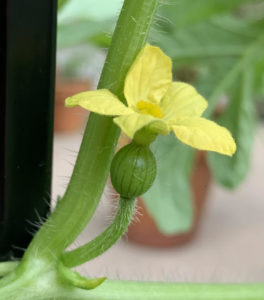
Fertilizer
It will help to use an organic liquid fertilizer once a week to promote growth. I like this one. Or you can use an organic granular fertilizer about once a month or according to package directions. Here’s the one I use. If you are curious about why organic fertilizer is preferable to chemical fertilizer, (i.e., synthetic ones), be sure to check out this helpful article.
Add a Trellis
Add a simple trellis next to the container so that the watermelon vines can grow vertically. You will need to guide them up the trellis as they grow. Even melons from compact varieties are heavy so you will also need to add some kind of support once they start to cause the vine to sag. Otherwise, the weight of the melon may break the vine. Use a section of pantyhose, t-shirt, or other material to cradle each melon. Whatever you use it needs to be able to accommodate the melon’s ever-growing size, shape, and weight. Think of it as a hammock for the summer fruit.
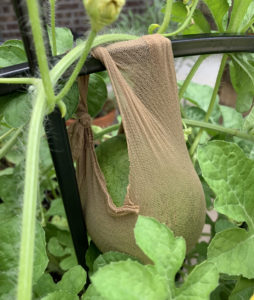
Pollinators
Watermelon plants have both male and female flowers that require pollinating. Bees, wasps, butterflies, and other pollinators will usually do the job for you. But if you have few pollinators in your area, you may need to hand pollinate them. Follow the directions in this article on how to hand pollinate zucchini plants. It is the same process except watermelon flowers are much smaller.
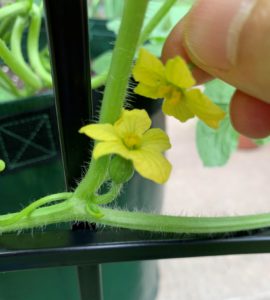
Pests
Many fruits and vegetables grown during the summer months have a long list of potential pests, and watermelon is no different. You may find aphids, leaf miners, cucumber beetles, spider mites, thrips, leaf-footed bugs, whiteflies, and flea beetles on your plants. In addition, you may find that rind worms, which is any caterpillar that will eat the rind, love the sweet-tasting fruit as much as you do. These include armyworms, cabbage loopers, and corn earworms, among others. And of course, grasshoppers and squash bugs may also be a problem. Follow the links to find out how to treat these pests, but in general, you can make a spray with neem oil to effectively treat them. You can learn more about neem oil, how it works, and a DIY recipe in this helpful article.
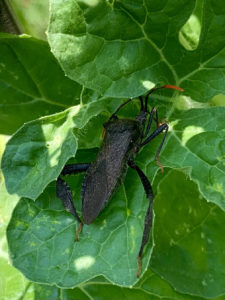
Diseases
In addition to pests, diseases may also attack watermelon vines and fruit, such as Cercospora leaf spot, downy mildew, powdery mildew, fusarium wilt, verticillium wilt, and root knot nematodes. You can find out how to treat these diseases organically by following the links.
Do not be overwhelmed by all of the potential pests and diseases you may encounter. Chances are you will only have one or two issues to deal with each season, and if you love watermelon, it will be worth the effort to grow your own!
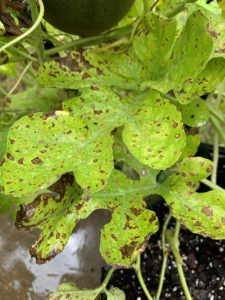
Harvest
If you want to harvest sweet, juicy watermelon then you will need to keep your plants as stress-free as possible. The happier the plants, the tastier the fruit will be. Things that stress a watermelon include pressure from pests and diseases, as well as over watering and underwatering.
One of the best ways to make sure your plants get the care they deserve is to visit the garden at least once, if not twice a day. The more you check on them the quicker you will discover any issues that could stress the plants out and the quicker you can remedy them.
Additionally, if you limit the number of melons to 4 to 6 fruits per vine, this will also help produce better melons since the plant can put its energy into growing these melons and not expend its energy growing too many melons.
Depending on the variety, watermelons will be ready to harvest in about 80 to 90 days after planting the seed. The variety you grow may take more or less time so be sure to check the seed packet for approximate harvest dates.
One of the best ways to determine if a watermelon is ready to be picked is to find the tendril that is growing closest to the melon. If it is dried and almost dead then the fruit should be ready to harvest! If it is shriveled completely then the melon may be overripe.
It is a good idea to succession plant so that not all of the watermelons ripen at the same time. Wait about two weeks in between plantings to have watermelons throughout the season.
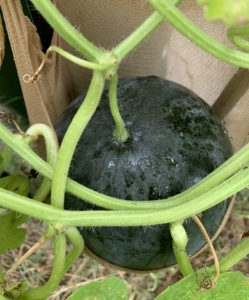
Watermelon Varieties
Here is a list of several compact varieties you may want to try: Sugar Baby, Jubilee, Crimson Sweet, Solitaire, Moon and Stars, Early Moonbeam, Millennium, Golden Midget, and Orange Sweet.
Remember, just because you don’t have a lot of room in your garden doesn’t mean you can’t grow watermelon. If I can grow them in containers, you can, too!
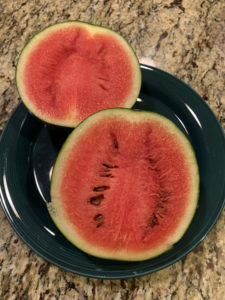
Thank you for reading this article! If you found it helpful, please consider sharing it with others via email and social media!

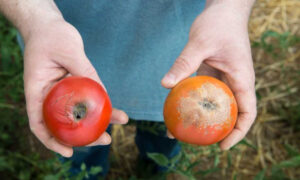
So well presented, Hildy. Thorough and easy to follow. Thanks!
Thanks so much, Rosemary!